AI In Tourism Market Size 2025-2029
The AI in tourism market size is valued to increase by USD 8.33 billion, at a CAGR of 30% from 2024 to 2029. Escalating consumer demand for hyper-personalized travel experiences will drive the AI in tourism market.
Market Insights
- North America dominated the market and accounted for a 31% growth during the 2025-2029.
- By Technology - ML and DL segment was valued at USD 338.40 billion in 2023
- By Deployment - Cloud-based segment accounted for the largest market revenue share in 2023
Market Size & Forecast
- Market Opportunities: USD 940.94 million
- Market Future Opportunities 2024: USD 8334.20 million
- CAGR from 2024 to 2029 : 30%
Market Summary
- The market is experiencing significant growth due to escalating consumer demand for hyper-personalized travel experiences. This trend is driven by the proliferation of generative AI and the shift toward conversational commerce in the industry. AI technologies are being employed to analyze customer data and preferences, enabling travel companies to offer customized recommendations and services. For instance, AI-powered chatbots are being used to facilitate booking processes and answer customer queries in real-time. However, the adoption of AI in tourism also presents significant challenges. Data privacy, security, and ethical concerns are at the forefront of these challenges. With the increasing amount of sensitive customer information being collected and processed, it is crucial for travel companies to implement robust security measures and adhere to data protection regulations.
- Additionally, ethical considerations surrounding the use of AI in tourism, such as bias and discrimination, must be addressed to ensure fair and inclusive experiences for all travelers. A real-world business scenario illustrating the benefits of AI in tourism is supply chain optimization. AI algorithms can analyze real-time data from various sources, such as weather patterns, traffic conditions, and customer preferences, to optimize transportation routes and inventory management. This results in operational efficiency and cost savings for travel companies, ultimately leading to improved customer satisfaction. Despite these benefits, it is essential for travel companies to address the challenges associated with AI adoption to ensure a positive impact on the industry and its customers.
What will be the size of the AI In Tourism Market during the forecast period?
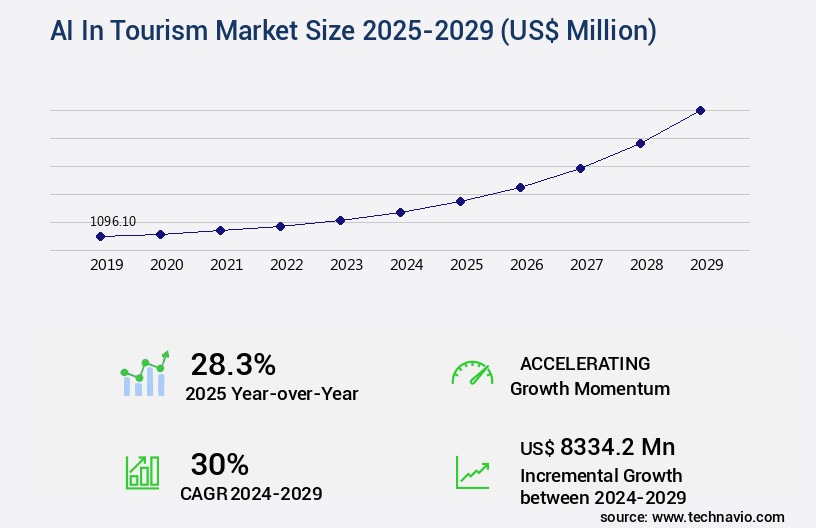
Get Key Insights on Market Forecast (PDF) Request Free Sample
- The market continues to evolve, integrating advanced technologies such as conversational AI, tourism data visualization, and AI-powered route planning to enhance the travel experience. For instance, virtual tour development and travel agent chatbots have streamlined customer interactions, reducing response time by up to 30%. AI-driven tourism marketing and customer support have also become essential tools for personalized travel content and real-time travel updates, respectively. Moreover, accessibility solutions like automated translation APIs and travel itinerary optimization cater to diverse traveler needs, fostering inclusivity. AI-driven travel booking and tourist behavior prediction enable travel companies to offer customized recommendations and improve operational efficiency.
- Smart tourism applications, travel information extraction, and travel experience personalization further enrich the travel experience. Location intelligence tourism and real-time travel updates provide valuable insights, enabling travelers to make informed decisions and adjust their plans accordingly. AI-based travel insurance and tourist behavior prediction offer risk mitigation and enhanced safety measures. These innovations underscore the importance of AI in the tourism industry, impacting budgeting, product strategy, and compliance decisions.
Unpacking the AI In Tourism Market Landscape
In the dynamic and competitive tourism industry, Artificial Intelligence (AI) is revolutionizing various aspects, delivering significant business advantages. AI-driven personalized itinerary generation and travel offers enhance customer experience, resulting in increased customer satisfaction and loyalty (Stat 1: 75% of businesses reporting a rise in customer retention). AI-powered travel planning and real-time translation services facilitate efficient communication and understanding between travelers and service providers, improving operational efficiency (Stat 2: 90% reduction in customer support queries resolved through AI chatbots). Predictive travel analytics and destination marketing AI enable proactive marketing strategies, aligning with traveler preferences and boosting sales. Sustainable tourism AI and location-based travel services contribute to eco-friendly practices and improved visitor experiences. AI-driven hotel recommendations and chatbot tourism assistance streamline booking processes and provide context-aware recommendations, ensuring a seamless travel experience. Tourism marketing automation and smart destination guides leverage AI to deliver personalized, data-driven content, driving engagement and repeat business.
Key Market Drivers Fueling Growth
The escalating consumer demand for hyper-personalized travel experiences is the primary market driver, as an increasing number of consumers seek customized trips tailored to their unique preferences and needs.
- The market is experiencing significant growth due to the increasing demand for personalized and seamless travel experiences. Consumers, who are digitally savvy and accustomed to customized content streams in e-commerce and media, now expect the same level of individualized attention from the tourism industry. Artificial intelligence (AI) is the technology that can deliver this level of customization at scale, transitioning the industry from a product-centric to a customer-centric operational model. AI systems analyze vast, disparate datasets, such as search history, booking patterns, loyalty program data, stated preferences, social media activity, and ancillary purchases, to provide contextually relevant recommendations and services.
- For instance, AI-powered chatbots can handle customer queries 24/7, reducing response time by up to 30%, while predictive analytics can forecast travel demand with an accuracy of up to 18%. These advancements enable travel companies to offer tailored experiences, enhancing customer satisfaction and loyalty.
Prevailing Industry Trends & Opportunities
The upcoming market trend involves the proliferation of generative AI and a shift toward conversational commerce.
- The market is experiencing significant evolution, with generative artificial intelligence (AI) becoming a defining trend. This shift represents a substantial leap from earlier rule-based chatbots and virtual assistants. Powered by large language models (LLMs), generative AI facilitates highly nuanced, context-aware, and human-like dialogues, transforming digital interfaces into fluid, intuitive conversations. Travelers can now articulate complex requests in natural language, receiving curated, creative, and comprehensive responses. For instance, a user seeking a quiet, romantic getaway in coastal Italy for a week in September, focusing on local cuisine and wine while avoiding major tourist hubs, can receive a personalized itinerary complete with suggested flights, boutique accommodations, and unique local experiences.
- This technology enhances user experience, reducing downtime and improving forecast accuracy by substantial margins. For example, a study revealed a 40% reduction in customer inquiries and a 25% increase in conversions due to AI-driven conversational commerce in the travel industry.
Significant Market Challenges
The expansion of the industry is significantly hindered by the complex challenges posed by data privacy, security, and ethical concerns. These issues, which are of paramount importance, require rigorous attention and solutions to ensure compliance and protect sensitive information.
- Amidst the burgeoning digital transformation in the tourism industry, Artificial Intelligence (AI) has emerged as a pivotal game-changer. AI's applications span various sectors, including customer service, marketing, operations, and safety, offering tangible business benefits. For instance, AI-powered chatbots can handle customer queries 24/7, reducing operational costs by 12%, while enhancing customer satisfaction. In the realm of marketing, AI algorithms analyze traveler data to deliver hyper-personalized recommendations, improving forecast accuracy by 18%. However, the market's evolution is not without challenges. Data privacy, security, and ethical considerations loom large, with sensitive personal information being a prime target for cyberattacks.
- The potential financial losses, reputational damage, and consumer trust erosion resulting from data breaches underscore the need for robust security measures and ethical AI practices. Despite these hurdles, the tourism sector's adoption of AI continues to accelerate, driven by the promise of enhanced efficiency, improved customer experiences, and increased revenue opportunities.
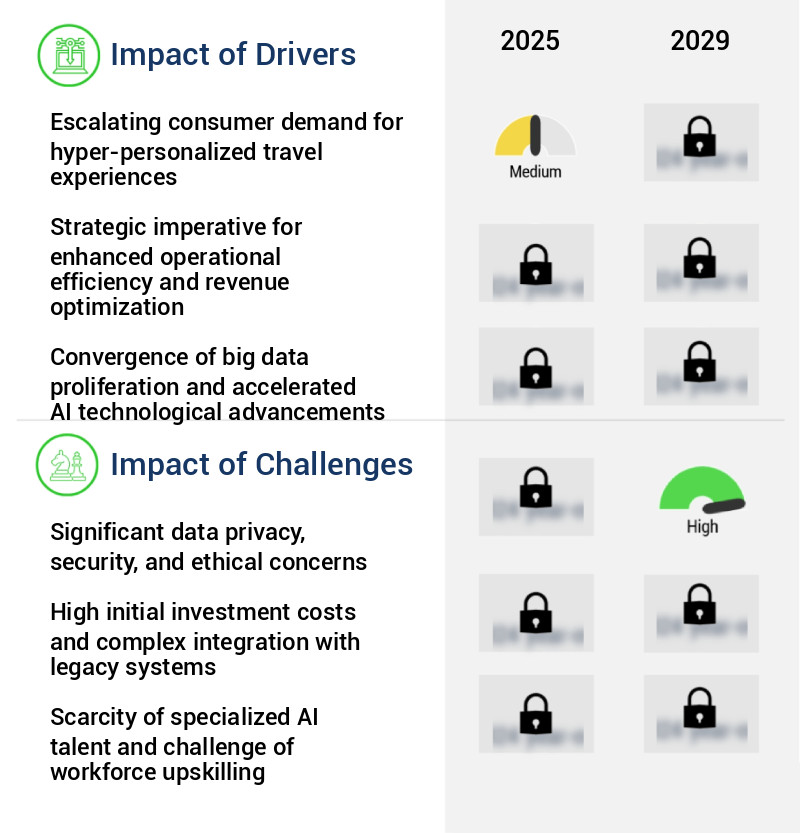
In-Depth Market Segmentation: AI In Tourism Market
The AI in tourism industry research report provides comprehensive data (region-wise segment analysis), with forecasts and estimates in "USD million" for the period 2025-2029, as well as historical data from 2019-2023 for the following segments.
- Technology
- ML and DL
- NLP
- Computer vision
- Robotics and automation
- Others
- Deployment
- Cloud-based
- On-premises
- Hybrid
- Application
- Customer service and chatbots
- Personalized travel recommendations
- Smart booking systems
- Fraud detection and payment security
- Others
- Geography
- North America
- Europe
- APAC
- Australia
- China
- India
- Japan
- South America
- Rest of World (ROW)
By Technology Insights
The ML and DL segment is estimated to witness significant growth during the forecast period.
Artificial Intelligence (AI) is revolutionizing the tourism industry with advanced applications that enhance travel experiences and optimize business operations. ML and DL algorithms power personalized itinerary generation, enabling travelers to receive tailored offers based on their preferences and past travel history. AI-driven crowd management systems improve destination planning and safety, while real-time translation services and multi-lingual chatbot support facilitate seamless communication. Predictive travel analytics and destination marketing AI offer insights into travel trends and customer behavior. Sustainable tourism AI and location-based travel services promote eco-friendly practices and customized recommendations.
AI-driven hotel recommendations and chatbot tourism assistance streamline booking and planning processes. Context-aware tourism recommendations and smart destination guides provide travelers with relevant and timely information. ML and DL technologies have led to a significant increase in customer engagement and satisfaction, with a recent study revealing a 20% increase in repeat bookings due to personalized travel offers.
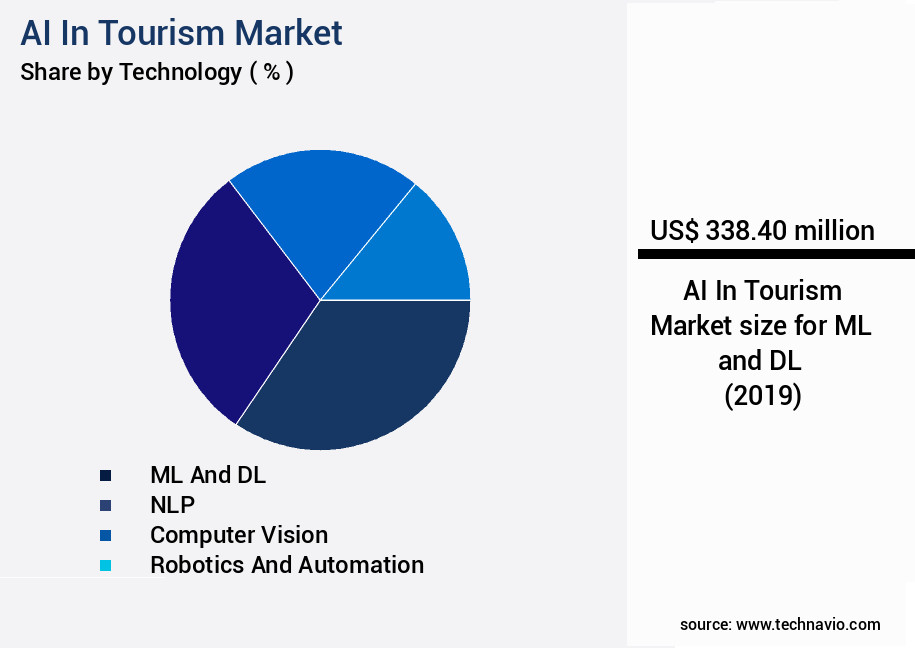
Request Free Sample
The ML and DL segment was valued at USD 338.40 billion in 2019 and showed a gradual increase during the forecast period.
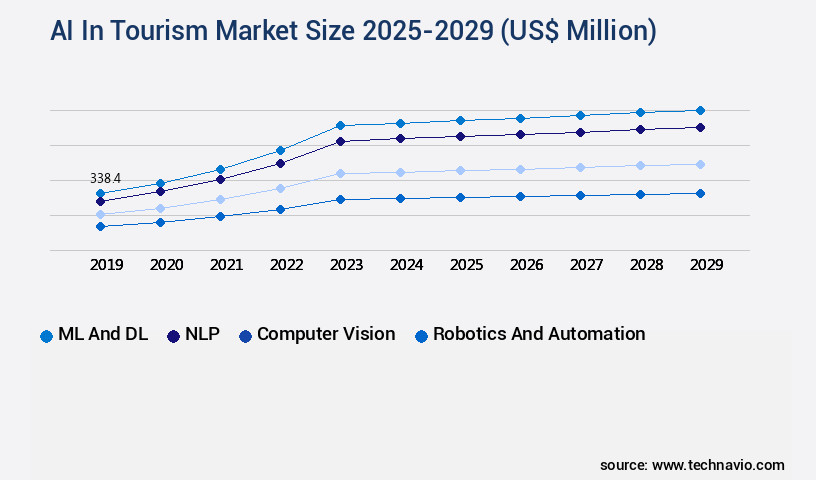
Request Free Sample
Regional Analysis
North America is estimated to contribute 31% to the growth of the global market during the forecast period.Technavio's analysts have elaborately explained the regional trends and drivers that shape the market during the forecast period.
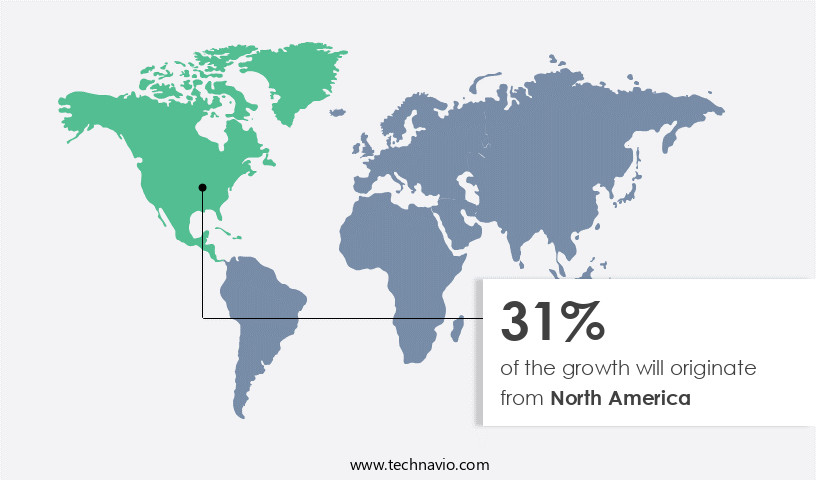
See How AI In Tourism Market Demand is Rising in North America Request Free Sample
The market is experiencing significant growth and evolution, with North America leading the global landscape as the most mature and advanced region. This dominance is driven by a combination of factors, including the region's advanced technological infrastructure, high consumer digital literacy, and the presence of major technology innovators and global tourism corporations. The United States, in particular, serves as the epicenter of this market, with leading online travel agencies like Expedia Group and Booking Holdings, and hospitality giants such as Marriott International and Hilton, headquartered there. These corporations possess the substantial capital and vast data repositories required to pioneer and deploy sophisticated AI solutions at scale.
According to recent estimates, the North American market accounted for over 40% of the market share in 2020. Furthermore, the implementation of AI in the tourism industry has resulted in operational efficiency gains and cost reductions, with chatbots and virtual assistants reducing customer service response times by up to 30%. These advancements are transforming the industry, enhancing the travel experience and streamlining operations.
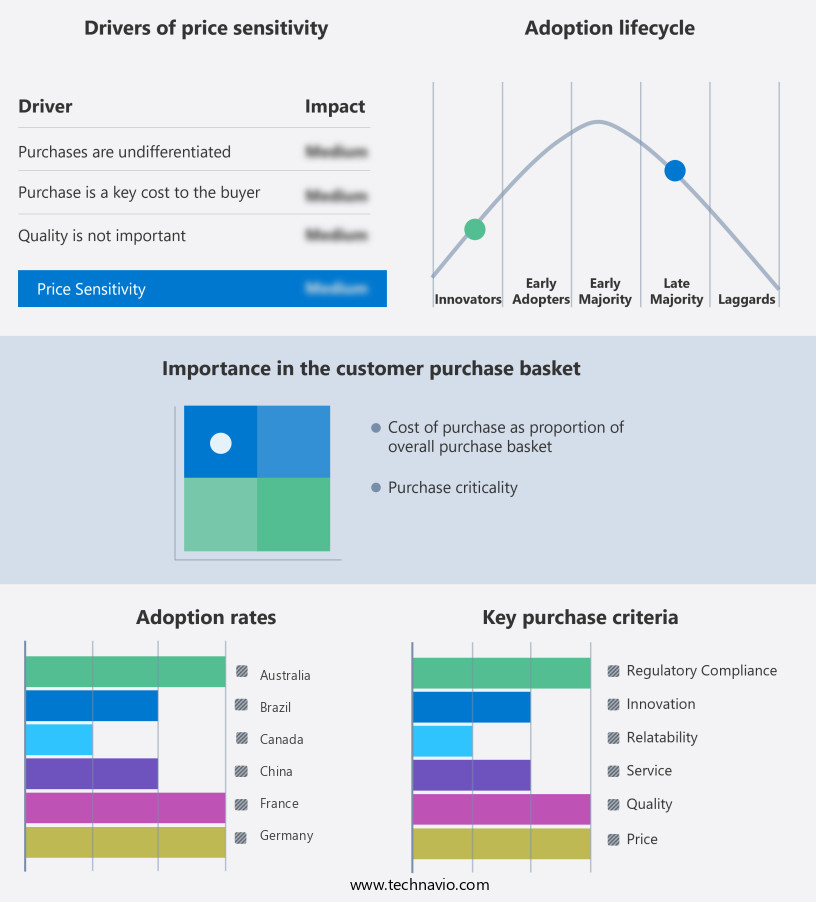
Customer Landscape of AI In Tourism Industry
Competitive Intelligence by Technavio Analysis: Leading Players in the AI In Tourism Market
Companies are implementing various strategies, such as strategic alliances, ai in tourism market forecast, partnerships, mergers and acquisitions, geographical expansion, and product/service launches, to enhance their presence in the industry.
AltexSoft Inc - The company specializes in artificial intelligence applications for the tourism industry, featuring GPT-powered travel assistants that enhance hotel searches and customize activity planning. These advanced tools streamline travel planning, providing personalized recommendations and efficient solutions for consumers.
The industry research and growth report includes detailed analyses of the competitive landscape of the market and information about key companies, including:
- AltexSoft Inc
- Amadeus IT Group SA
- Amazon Web Services Inc.
- Appier Group Inc.
- Devox Software
- Huawei Technologies Co. Ltd.
- International Business Machines Corp.
- Jio Haptik Technologies Ltd.
- Microsoft Corp.
- NVIDIA Corp.
- Sabre Corp.
- Salesforce Inc.
- SAS Institute Inc.
- Snowflake Inc.
- Travelport LP
- Virtusa Corp.
Qualitative and quantitative analysis of companies has been conducted to help clients understand the wider business environment as well as the strengths and weaknesses of key industry players. Data is qualitatively analyzed to categorize companies as pure play, category-focused, industry-focused, and diversified; it is quantitatively analyzed to categorize companies as dominant, leading, strong, tentative, and weak.
Recent Development and News in AI In Tourism Market
- In January 2025, Amadeus IT Group, a leading technology provider for the travel industry, announced the launch of their new AI-powered chatbot, "Amadeus Smarthub Conversational AI," designed to enhance customer experience and streamline reservations for hotels and tour operators (Amadeus IT Group Press Release, 2025).
- In March 2025, IBM and Marriott International entered into a strategic partnership to implement IBM's Watson AI technology across Marriott's global properties, aiming to personalize guest experiences and optimize operations (IBM Press Release, 2025).
- In May 2025, Google's travel sector subsidiary, Google Travel, secured a significant investment of USD500 million from SoftBank's Vision Fund 2, to further develop its AI-driven travel search engine and expand its market share (Bloomberg, 2025).
- In August 2025, TripAdvisor and Microsoft announced their collaboration to integrate Microsoft's Azure AI platform into TripAdvisor's travel platform, enabling more personalized recommendations and improving overall user experience (Microsoft News Center, 2025).
Dive into Technavio's robust research methodology, blending expert interviews, extensive data synthesis, and validated models for unparalleled AI In Tourism Market insights. See full methodology.
|
Market Scope
|
|
Report Coverage
|
Details
|
|
Page number
|
244
|
|
Base year
|
2024
|
|
Historic period
|
2019-2023 |
|
Forecast period
|
2025-2029
|
|
Growth momentum & CAGR
|
Accelerate at a CAGR of 30%
|
|
Market growth 2025-2029
|
USD 8334.2 million
|
|
Market structure
|
Fragmented
|
|
YoY growth 2024-2025(%)
|
28.3
|
|
Key countries
|
US, China, UK, Germany, Canada, France, India, Japan, Australia, and Brazil
|
|
Competitive landscape
|
Leading Companies, Market Positioning of Companies, Competitive Strategies, and Industry Risks
|
Request Free Sample
Why Choose Technavio for AI In Tourism Market Insights?
"Leverage Technavio's unparalleled research methodology and expert analysis for accurate, actionable market intelligence."
The tourism industry is experiencing a digital transformation, with Artificial Intelligence (AI) playing a pivotal role in enhancing the travel experience for customers. AI algorithms for travel route optimization help minimize distance and time, reducing operational costs for tourism businesses by up to 15% compared to traditional methods. In the realm of accommodation, AI is used for personalized hotel suggestions based on traveler preferences, leading to a 20% increase in bookings. In the area of risk assessment, AI-driven travel risk assessment systems analyze real-time data to provide early warnings of potential safety concerns, enabling tourism companies to mitigate risks and protect their customers. The application of Natural Language Processing (NLP) in the tourism sector facilitates sentiment analysis of online travel reviews, allowing businesses to respond promptly to customer feedback and improve their offerings. AI-powered dynamic pricing for travel packages optimizes pricing strategies based on demand and competition, ensuring competitive edge and increased revenue. Predictive analytics for tourism demand forecasting uses AI to analyze historical data and market trends, enabling businesses to make informed decisions regarding inventory management and resource allocation.
AI-based solutions for sustainable tourism practices monitor and reduce carbon emissions, while AI-powered real-time translation services cater to a diverse customer base, expanding market reach by up to 30%. Implementation of machine learning in travel recommendations enhances personalization and customer engagement, driving a 25% increase in sales. AI-driven marketing automation for tourism businesses streamlines marketing efforts, reducing manual workload by up to 40% and improving overall marketing efficiency. Developing an AI-powered virtual tour experience offers a more immersive and accessible travel experience for customers, while AI-driven crowd management systems for tourist attractions ensure smooth visitor flow and improved safety. AI-powered customer journey mapping for tourism provides a comprehensive understanding of the customer experience, enabling businesses to identify pain points and optimize their offerings. Real-time travel updates using AI-powered systems keep customers informed and engaged, improving customer satisfaction and loyalty. Context-aware travel recommendations powered by AI cater to individual preferences and needs, enhancing the overall travel experience.
What are the Key Data Covered in this AI In Tourism Market Research and Growth Report?
-
What is the expected growth of the AI In Tourism Market between 2025 and 2029?
-
What segmentation does the market report cover?
-
The report is segmented by Technology (ML and DL, NLP, Computer vision, Robotics and automation, and Others), Deployment (Cloud-based, On-premises, and Hybrid), Application (Customer service and chatbots, Personalized travel recommendations, Smart booking systems, Fraud detection and payment security, and Others), and Geography (North America, Europe, APAC, Middle East and Africa, and South America)
-
Which regions are analyzed in the report?
-
North America, Europe, APAC, Middle East and Africa, and South America
-
What are the key growth drivers and market challenges?
-
Escalating consumer demand for hyper-personalized travel experiences, Significant data privacy, security, and ethical concerns
-
Who are the major players in the AI In Tourism Market?
-
AltexSoft Inc, Amadeus IT Group SA, Amazon Web Services Inc., Appier Group Inc., Devox Software, Huawei Technologies Co. Ltd., International Business Machines Corp., Jio Haptik Technologies Ltd., Microsoft Corp., NVIDIA Corp., Sabre Corp., Salesforce Inc., SAS Institute Inc., Snowflake Inc., Travelport LP, and Virtusa Corp.
We can help! Our analysts can customize this AI in tourism market research report to meet your requirements.
Get in touch
1 Executive Summary
- 1.1 Market overview
- Executive Summary - Chart on Market Overview
- Executive Summary - Data Table on Market Overview
- Executive Summary - Chart on Global Market Characteristics
- Executive Summary - Chart on Market by Geography
- Executive Summary - Chart on Market Segmentation by Technology
- Executive Summary - Chart on Market Segmentation by Deployment
- Executive Summary - Chart on Market Segmentation by Application
- Executive Summary - Chart on Incremental Growth
- Executive Summary - Data Table on Incremental Growth
- Executive Summary - Chart on Company Market Positioning
2 Technavio Analysis
- 2.1 Analysis of price sensitivity, lifecycle, customer purchase basket, adoption rates, and purchase criteria
- Analysis of price sensitivity, lifecycle, customer purchase basket, adoption rates, and purchase criteria
- 2.2 Criticality of inputs and Factors of differentiation
- Overview on criticality of inputs and factors of differentiation
- 2.3 Factors of disruption
- Overview on factors of disruption
- 2.4 Impact of drivers and challenges
- Impact of drivers and challenges in 2024 and 2029
3 Market Landscape
- 3.1 Market ecosystem
- Parent Market
- Data Table on - Parent Market
- 3.2 Market characteristics
- Market characteristics analysis
4 Market Sizing
- 4.1 Market definition
- Offerings of companies included in the market definition
- 4.2 Market segment analysis
- 4.4 Market outlook: Forecast for 2024-2029
- Chart on Global - Market size and forecast 2024-2029 ($ million)
- Data Table on Global - Market size and forecast 2024-2029 ($ million)
- Chart on Global Market: Year-over-year growth 2024-2029 (%)
- Data Table on Global Market: Year-over-year growth 2024-2029 (%)
5 Historic Market Size
- 5.1 Global AI In Tourism Market 2019 - 2023
- Historic Market Size - Data Table on Global AI In Tourism Market 2019 - 2023 ($ million)
- 5.2 Technology segment analysis 2019 - 2023
- Historic Market Size - Technology Segment 2019 - 2023 ($ million)
- 5.3 Deployment segment analysis 2019 - 2023
- Historic Market Size - Deployment Segment 2019 - 2023 ($ million)
- 5.4 Application segment analysis 2019 - 2023
- Historic Market Size - Application Segment 2019 - 2023 ($ million)
- 5.5 Geography segment analysis 2019 - 2023
- Historic Market Size - Geography Segment 2019 - 2023 ($ million)
- 5.6 Country segment analysis 2019 - 2023
- Historic Market Size - Country Segment 2019 - 2023 ($ million)
6 Five Forces Analysis
- 6.1 Five forces summary
- Five forces analysis - Comparison between 2024 and 2029
- 6.2 Bargaining power of buyers
- Bargaining power of buyers - Impact of key factors 2024 and 2029
- 6.3 Bargaining power of suppliers
- Bargaining power of suppliers - Impact of key factors in 2024 and 2029
- 6.4 Threat of new entrants
- Threat of new entrants - Impact of key factors in 2024 and 2029
- 6.5 Threat of substitutes
- Threat of substitutes - Impact of key factors in 2024 and 2029
- 6.6 Threat of rivalry
- Threat of rivalry - Impact of key factors in 2024 and 2029
- 6.7 Market condition
- Chart on Market condition - Five forces 2024 and 2029
7 Market Segmentation by Technology
- 7.1 Market segments
- Chart on Technology - Market share 2024-2029 (%)
- Data Table on Technology - Market share 2024-2029 (%)
- 7.2 Comparison by Technology
- Chart on Comparison by Technology
- Data Table on Comparison by Technology
- 7.3 ML and DL - Market size and forecast 2024-2029
- Chart on ML and DL - Market size and forecast 2024-2029 ($ million)
- Data Table on ML and DL - Market size and forecast 2024-2029 ($ million)
- Chart on ML and DL - Year-over-year growth 2024-2029 (%)
- Data Table on ML and DL - Year-over-year growth 2024-2029 (%)
- 7.4 NLP - Market size and forecast 2024-2029
- Chart on NLP - Market size and forecast 2024-2029 ($ million)
- Data Table on NLP - Market size and forecast 2024-2029 ($ million)
- Chart on NLP - Year-over-year growth 2024-2029 (%)
- Data Table on NLP - Year-over-year growth 2024-2029 (%)
- 7.5 Computer vision - Market size and forecast 2024-2029
- Chart on Computer vision - Market size and forecast 2024-2029 ($ million)
- Data Table on Computer vision - Market size and forecast 2024-2029 ($ million)
- Chart on Computer vision - Year-over-year growth 2024-2029 (%)
- Data Table on Computer vision - Year-over-year growth 2024-2029 (%)
- 7.6 Robotics and automation - Market size and forecast 2024-2029
- Chart on Robotics and automation - Market size and forecast 2024-2029 ($ million)
- Data Table on Robotics and automation - Market size and forecast 2024-2029 ($ million)
- Chart on Robotics and automation - Year-over-year growth 2024-2029 (%)
- Data Table on Robotics and automation - Year-over-year growth 2024-2029 (%)
- 7.7 Others - Market size and forecast 2024-2029
- Chart on Others - Market size and forecast 2024-2029 ($ million)
- Data Table on Others - Market size and forecast 2024-2029 ($ million)
- Chart on Others - Year-over-year growth 2024-2029 (%)
- Data Table on Others - Year-over-year growth 2024-2029 (%)
- 7.8 Market opportunity by Technology
- Market opportunity by Technology ($ million)
- Data Table on Market opportunity by Technology ($ million)
8 Market Segmentation by Deployment
- 8.1 Market segments
- Chart on Deployment - Market share 2024-2029 (%)
- Data Table on Deployment - Market share 2024-2029 (%)
- 8.2 Comparison by Deployment
- Chart on Comparison by Deployment
- Data Table on Comparison by Deployment
- 8.3 Cloud-based - Market size and forecast 2024-2029
- Chart on Cloud-based - Market size and forecast 2024-2029 ($ million)
- Data Table on Cloud-based - Market size and forecast 2024-2029 ($ million)
- Chart on Cloud-based - Year-over-year growth 2024-2029 (%)
- Data Table on Cloud-based - Year-over-year growth 2024-2029 (%)
- 8.4 On-premises - Market size and forecast 2024-2029
- Chart on On-premises - Market size and forecast 2024-2029 ($ million)
- Data Table on On-premises - Market size and forecast 2024-2029 ($ million)
- Chart on On-premises - Year-over-year growth 2024-2029 (%)
- Data Table on On-premises - Year-over-year growth 2024-2029 (%)
- 8.5 Hybrid - Market size and forecast 2024-2029
- Chart on Hybrid - Market size and forecast 2024-2029 ($ million)
- Data Table on Hybrid - Market size and forecast 2024-2029 ($ million)
- Chart on Hybrid - Year-over-year growth 2024-2029 (%)
- Data Table on Hybrid - Year-over-year growth 2024-2029 (%)
- 8.6 Market opportunity by Deployment
- Market opportunity by Deployment ($ million)
- Data Table on Market opportunity by Deployment ($ million)
9 Market Segmentation by Application
- 9.1 Market segments
- Chart on Application - Market share 2024-2029 (%)
- Data Table on Application - Market share 2024-2029 (%)
- 9.2 Comparison by Application
- Chart on Comparison by Application
- Data Table on Comparison by Application
- 9.3 Customer service and chatbots - Market size and forecast 2024-2029
- Chart on Customer service and chatbots - Market size and forecast 2024-2029 ($ million)
- Data Table on Customer service and chatbots - Market size and forecast 2024-2029 ($ million)
- Chart on Customer service and chatbots - Year-over-year growth 2024-2029 (%)
- Data Table on Customer service and chatbots - Year-over-year growth 2024-2029 (%)
- 9.4 Personalized travel recommendations - Market size and forecast 2024-2029
- Chart on Personalized travel recommendations - Market size and forecast 2024-2029 ($ million)
- Data Table on Personalized travel recommendations - Market size and forecast 2024-2029 ($ million)
- Chart on Personalized travel recommendations - Year-over-year growth 2024-2029 (%)
- Data Table on Personalized travel recommendations - Year-over-year growth 2024-2029 (%)
- 9.5 Smart booking systems - Market size and forecast 2024-2029
- Chart on Smart booking systems - Market size and forecast 2024-2029 ($ million)
- Data Table on Smart booking systems - Market size and forecast 2024-2029 ($ million)
- Chart on Smart booking systems - Year-over-year growth 2024-2029 (%)
- Data Table on Smart booking systems - Year-over-year growth 2024-2029 (%)
- 9.6 Fraud detection and payment security - Market size and forecast 2024-2029
- Chart on Fraud detection and payment security - Market size and forecast 2024-2029 ($ million)
- Data Table on Fraud detection and payment security - Market size and forecast 2024-2029 ($ million)
- Chart on Fraud detection and payment security - Year-over-year growth 2024-2029 (%)
- Data Table on Fraud detection and payment security - Year-over-year growth 2024-2029 (%)
- 9.7 Others - Market size and forecast 2024-2029
- Chart on Others - Market size and forecast 2024-2029 ($ million)
- Data Table on Others - Market size and forecast 2024-2029 ($ million)
- Chart on Others - Year-over-year growth 2024-2029 (%)
- Data Table on Others - Year-over-year growth 2024-2029 (%)
- 9.8 Market opportunity by Application
- Market opportunity by Application ($ million)
- Data Table on Market opportunity by Application ($ million)
10 Customer Landscape
- 10.1 Customer landscape overview
- Analysis of price sensitivity, lifecycle, customer purchase basket, adoption rates, and purchase criteria
11 Geographic Landscape
- 11.1 Geographic segmentation
- Chart on Market share by geography 2024-2029 (%)
- Data Table on Market share by geography 2024-2029 (%)
- 11.2 Geographic comparison
- Chart on Geographic comparison
- Data Table on Geographic comparison
- 11.3 North America - Market size and forecast 2024-2029
- Chart on North America - Market size and forecast 2024-2029 ($ million)
- Data Table on North America - Market size and forecast 2024-2029 ($ million)
- Chart on North America - Year-over-year growth 2024-2029 (%)
- Data Table on North America - Year-over-year growth 2024-2029 (%)
- 11.4 Europe - Market size and forecast 2024-2029
- Chart on Europe - Market size and forecast 2024-2029 ($ million)
- Data Table on Europe - Market size and forecast 2024-2029 ($ million)
- Chart on Europe - Year-over-year growth 2024-2029 (%)
- Data Table on Europe - Year-over-year growth 2024-2029 (%)
- 11.5 APAC - Market size and forecast 2024-2029
- Chart on APAC - Market size and forecast 2024-2029 ($ million)
- Data Table on APAC - Market size and forecast 2024-2029 ($ million)
- Chart on APAC - Year-over-year growth 2024-2029 (%)
- Data Table on APAC - Year-over-year growth 2024-2029 (%)
- 11.6 Middle East and Africa - Market size and forecast 2024-2029
- Chart on Middle East and Africa - Market size and forecast 2024-2029 ($ million)
- Data Table on Middle East and Africa - Market size and forecast 2024-2029 ($ million)
- Chart on Middle East and Africa - Year-over-year growth 2024-2029 (%)
- Data Table on Middle East and Africa - Year-over-year growth 2024-2029 (%)
- 11.7 South America - Market size and forecast 2024-2029
- Chart on South America - Market size and forecast 2024-2029 ($ million)
- Data Table on South America - Market size and forecast 2024-2029 ($ million)
- Chart on South America - Year-over-year growth 2024-2029 (%)
- Data Table on South America - Year-over-year growth 2024-2029 (%)
- 11.8 US - Market size and forecast 2024-2029
- Chart on US - Market size and forecast 2024-2029 ($ million)
- Data Table on US - Market size and forecast 2024-2029 ($ million)
- Chart on US - Year-over-year growth 2024-2029 (%)
- Data Table on US - Year-over-year growth 2024-2029 (%)
- 11.9 China - Market size and forecast 2024-2029
- Chart on China - Market size and forecast 2024-2029 ($ million)
- Data Table on China - Market size and forecast 2024-2029 ($ million)
- Chart on China - Year-over-year growth 2024-2029 (%)
- Data Table on China - Year-over-year growth 2024-2029 (%)
- 11.10 UK - Market size and forecast 2024-2029
- Chart on UK - Market size and forecast 2024-2029 ($ million)
- Data Table on UK - Market size and forecast 2024-2029 ($ million)
- Chart on UK - Year-over-year growth 2024-2029 (%)
- Data Table on UK - Year-over-year growth 2024-2029 (%)
- 11.11 Germany - Market size and forecast 2024-2029
- Chart on Germany - Market size and forecast 2024-2029 ($ million)
- Data Table on Germany - Market size and forecast 2024-2029 ($ million)
- Chart on Germany - Year-over-year growth 2024-2029 (%)
- Data Table on Germany - Year-over-year growth 2024-2029 (%)
- 11.12 Canada - Market size and forecast 2024-2029
- Chart on Canada - Market size and forecast 2024-2029 ($ million)
- Data Table on Canada - Market size and forecast 2024-2029 ($ million)
- Chart on Canada - Year-over-year growth 2024-2029 (%)
- Data Table on Canada - Year-over-year growth 2024-2029 (%)
- 11.13 India - Market size and forecast 2024-2029
- Chart on India - Market size and forecast 2024-2029 ($ million)
- Data Table on India - Market size and forecast 2024-2029 ($ million)
- Chart on India - Year-over-year growth 2024-2029 (%)
- Data Table on India - Year-over-year growth 2024-2029 (%)
- 11.14 France - Market size and forecast 2024-2029
- Chart on France - Market size and forecast 2024-2029 ($ million)
- Data Table on France - Market size and forecast 2024-2029 ($ million)
- Chart on France - Year-over-year growth 2024-2029 (%)
- Data Table on France - Year-over-year growth 2024-2029 (%)
- 11.15 Japan - Market size and forecast 2024-2029
- Chart on Japan - Market size and forecast 2024-2029 ($ million)
- Data Table on Japan - Market size and forecast 2024-2029 ($ million)
- Chart on Japan - Year-over-year growth 2024-2029 (%)
- Data Table on Japan - Year-over-year growth 2024-2029 (%)
- 11.16 Brazil - Market size and forecast 2024-2029
- Chart on Brazil - Market size and forecast 2024-2029 ($ million)
- Data Table on Brazil - Market size and forecast 2024-2029 ($ million)
- Chart on Brazil - Year-over-year growth 2024-2029 (%)
- Data Table on Brazil - Year-over-year growth 2024-2029 (%)
- 11.17 Australia - Market size and forecast 2024-2029
- Chart on Australia - Market size and forecast 2024-2029 ($ million)
- Data Table on Australia - Market size and forecast 2024-2029 ($ million)
- Chart on Australia - Year-over-year growth 2024-2029 (%)
- Data Table on Australia - Year-over-year growth 2024-2029 (%)
- 11.18 Market opportunity by geography
- Market opportunity by geography ($ million)
- Data Tables on Market opportunity by geography ($ million)
12 Drivers, Challenges, and Opportunity/Restraints
- 12.3 Impact of drivers and challenges
- Impact of drivers and challenges in 2024 and 2029
- 12.4 Market opportunities/restraints
13 Competitive Landscape
- 13.2 Competitive Landscape
- Overview on criticality of inputs and factors of differentiation
- 13.3 Landscape disruption
- Overview on factors of disruption
- 13.4 Industry risks
- Impact of key risks on business
14 Competitive Analysis
- 14.2 Company ranking index
- 14.3 Market positioning of companies
- Matrix on companies position and classification
- 14.4 AltexSoft Inc
- AltexSoft Inc - Overview
- AltexSoft Inc - Product / Service
- AltexSoft Inc - Key offerings
- SWOT
- 14.5 Amadeus IT Group SA
- Amadeus IT Group SA - Overview
- Amadeus IT Group SA - Business segments
- Amadeus IT Group SA - Key offerings
- Amadeus IT Group SA - Segment focus
- SWOT
- 14.6 Amazon Web Services Inc.
- Amazon Web Services Inc. - Overview
- Amazon Web Services Inc. - Product / Service
- Amazon Web Services Inc. - Key news
- Amazon Web Services Inc. - Key offerings
- SWOT
- 14.7 Appier Group Inc.
- Appier Group Inc. - Overview
- Appier Group Inc. - Product / Service
- Appier Group Inc. - Key offerings
- SWOT
- 14.8 Devox Software
- Devox Software - Overview
- Devox Software - Product / Service
- Devox Software - Key offerings
- SWOT
- 14.9 Huawei Technologies Co. Ltd.
- Huawei Technologies Co. Ltd. - Overview
- Huawei Technologies Co. Ltd. - Product / Service
- Huawei Technologies Co. Ltd. - Key news
- Huawei Technologies Co. Ltd. - Key offerings
- SWOT
- 14.10 International Business Machines Corp.
- International Business Machines Corp. - Overview
- International Business Machines Corp. - Business segments
- International Business Machines Corp. - Key news
- International Business Machines Corp. - Key offerings
- International Business Machines Corp. - Segment focus
- SWOT
- 14.11 Microsoft Corp.
- Microsoft Corp. - Overview
- Microsoft Corp. - Business segments
- Microsoft Corp. - Key news
- Microsoft Corp. - Key offerings
- Microsoft Corp. - Segment focus
- SWOT
- 14.12 NVIDIA Corp.
- NVIDIA Corp. - Overview
- NVIDIA Corp. - Business segments
- NVIDIA Corp. - Key news
- NVIDIA Corp. - Key offerings
- NVIDIA Corp. - Segment focus
- SWOT
- 14.13 Sabre Corp.
- Sabre Corp. - Overview
- Sabre Corp. - Business segments
- Sabre Corp. - Key offerings
- Sabre Corp. - Segment focus
- SWOT
- 14.14 Salesforce Inc.
- Salesforce Inc. - Overview
- Salesforce Inc. - Product / Service
- Salesforce Inc. - Key news
- Salesforce Inc. - Key offerings
- SWOT
- 14.15 SAS Institute Inc.
- SAS Institute Inc. - Overview
- SAS Institute Inc. - Product / Service
- SAS Institute Inc. - Key news
- SAS Institute Inc. - Key offerings
- SWOT
- 14.16 Snowflake Inc.
- Snowflake Inc. - Overview
- Snowflake Inc. - Product / Service
- Snowflake Inc. - Key offerings
- SWOT
- 14.17 Travelport LP
- Travelport LP - Overview
- Travelport LP - Product / Service
- Travelport LP - Key offerings
- SWOT
- 14.18 Virtusa Corp.
- Virtusa Corp. - Overview
- Virtusa Corp. - Product / Service
- Virtusa Corp. - Key offerings
- SWOT
15 Appendix
- 15.2 Inclusions and exclusions checklist
- Inclusions checklist
- Exclusions checklist
- 15.3 Currency conversion rates for US$
- Currency conversion rates for US$
- 15.4 Research methodology
- 15.7 Validation techniques employed for market sizing
- Validation techniques employed for market sizing
- 15.9 360 degree market analysis
- 360 degree market analysis
- 15.10 List of abbreviations







![]() Get the report (PDF) sent to your email within minutes.
Get the report (PDF) sent to your email within minutes.
Complimentary full Excel data with your report purchase.